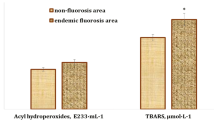Abstract
Blackfoot disease is a peripheral vascular disease resulting in gangrene of the lower extremities. Extensive epidemiological study implicates that high arsenic content in artesian well water is the responsible causal factor of the disease. In the present study the concentrations of arsenic, selenium, and zinc in the body fluids and hair of patients with Blackfoot disease, in comparison to age- and sex-matched normal controls, are investigated. Two analytical techniques that include atomic absorption spectrometry and neutron activation analysis were used for the analysis of urine, serum, hair, and whole blood. The analytical results indicate that hair arsenic of the patients is significantly higher than that of the controls, but still below the critical value of 1 μg/g. In addition, the patients showed significantly lower concentrations of Se and Zn in the urine and blood than the normal controls. The possible connection of these elements with the etiology of the disease is discussed.
Similar content being viewed by others
References
K. P. Chen and H. Y. Wu,J. Formosan Med. Assoc. 61, 611 (1962).
S. Yeh,Human Pathol. 4, 469 (1973).
E. Astolfi, et al.,Biol. Trace Elem. Res. 3, 133 (1981).
H. S. Yu, H. M. Sheu, S. S. Ko, L. C. Chiang, C. H. Chien, S. M. Lin, B. R. Tserng, and C. S. Chen,Internatl. J. Determ. 23, 258 (1984).
F. H. Lu, C. K. Yang, and K. H. Ling,J. Formosan Med. Assoc. 74, 596 (1975).
S. M. Lin, C. H. Chiang, and M. H. Yang,Biol. Trace Elem. Res. 8, 11 (1985).
S. Yeh and S. W. How, Reports, Institute of Pathology, National Taiwan University.14, 25 (1963).
E. J. Underwood,Trace Elements in Human and Animal Nutrition, 4th ed., Academic, New York, 1977, p. 219.
G. N. Schrauzer, D. A. White, J. McGuiness, C. J. Schneider, and L. Bell,Bioinorg. Chem. 9, 245 (1978).
J. C. Hasen and P. Kristensen,Arch. Toxicol 46, 273 (1980).
J. A. Fiorino, J. W. Jones, and S. G. Capar,Anal. Chem. 48, 120 (1976).
B. Welz and M. Melcher,Atomic Absorption Newsletter 18, 121 (1979).
C. Y. Wu, P. Y. Chen, M. H. Yang,Proc. Mod. Trends Act. Anal., Copenhagen, vol.I, 149–155, (1986).
S. M. Lin,Kaohsiung J. Med. Sci. 2, 100 (1986).
S. M. Lin,Radioisotopes 32, 155 (1983).
W. P. Tseng,J. Formosan Med. Assoc. 74, 37 (1975).
O. R. Mcletchie, L. P. M. Hefferman, O. A. Hayne, H. A. Ellenbeger, R. F. McCardy, and H. J. Thiebaux,J. Anal. Toxicol. 1, 170 (1977).
F. J. Lu, M. H. Tsai, and K. H. Ling,J. Formosan Med Assoc. 76, 58 (1977).
I. R. Jan, J. Y. Chen, F. J. Lu, and K. H. Ling,J. Formosan Med. Assoc. 77, 361 (1978).
F. J. Lu and K. H. Ling,J. Formosan Med. Assoc. 78, 314 (1979).
R. Masironi,Nuclear Activation Techniques in the Life Sciences.IAEA. Vienna, 1972, pp. 503–516.
W. J. Pories, J. H. Henzel, and J. A. Hennessen,Trace Subst. Environ. Health-1. Proc. Univ. Mo. Annu. Conf. 1st. 1968, p. 114.
A. S. Prasad and D. Oberleas,Trace Elements in Human Health and Disease. vol. I. Zinc and Copper. Academic, New York, 1976, p. 124.
Y. C. Awasthi, C. E. Beutler, and S. K. Srivastava,J. Biol. Chem. 250, 5144 (1975).
Y. C. Awasthi and D. O. Dao,Fed. Proc. 37, 1340 (1978).
H. J. Robberecht and H. A. Deelstra,Clinica Chimica Acta,136, 107 (1984).
F. J. Lu,J. Formosan Med. Assoc. 83, 1001 (1984).
T. M. Lin, W. T. Tsu, C. J. Chen and T. S. Tsai,J. Formosan Med. Assoc. 83, S. 84 (1984).
R. J. Shamberger,J. Natl. Cancer. Inst. 44, 931 (1970).
G. N. Schrauzer and D. Ishmael,Ann. Clin. Lab. Sci. 4, 441 (1974).
M. M. Jacobs, B. Jansson, and A. C. Griffin,Cancer Lett. 2, 133 (1977).
A. H. Daoud and A. C. Friffin,Cancer Lett. 9, 299 (1980).
H. J. Thompson and P. J. Pecci,J. Natl. Cancer Inst. 65, 1229 (1980).
Author information
Authors and Affiliations
Rights and permissions
About this article
Cite this article
Lin, S.M., Yang, M.H. Arsenic, selenium, and zinc in patients with blackfoot disease. Biol Trace Elem Res 15, 213–221 (1988). https://doi.org/10.1007/BF02990138
Received:
Accepted:
Issue Date:
DOI: https://doi.org/10.1007/BF02990138




